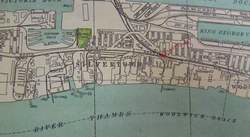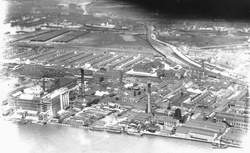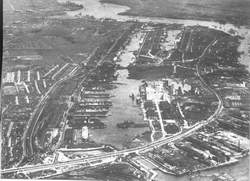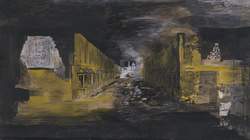Abandoned Communities ..... Central Silvertown
The painter Graham Sutherland visited Silvertown in 1941. He saw “the shells of long terraces of houses, great ― surprisingly wide ― perspectives of destruction seeming to recede into infinity. The windowless blocks were like sightless eyes.”
Sutherland produced a series of pictures to illustrate the consequences of the bombing of Silvertown. Three of his pictures appear (in May 2007) in a gallery in Tate Britain devoted to the theme of devastation. They depict the ruins of a street, a public house, and a paper warehouse.
Silvertown is a suburb of London between the River Thames and what used to be the three Royal docks. All of Silvertown was severely damaged by bombing in World War II, but the central part of it suffered the worst damage. The loss of population in central Silvertown was so great that I am willing to call it an abandoned community.
Silvertown and the neighbouring suburb of North Woolwich developed during the second half of the nineteenth century. Before that time it had been marshland, subject to flooding at high tide. In the 1840s, however, a railway line was built across it to connect to the ferry that crossed the Thames at North Woolwich. The area acquired additional significance in 1844 when the Metropolitan Building Act was passed. The Act banned toxic industries within most of the area covered by London at that time, but Silvertown was just outside the restricted area.
One of the first factories that came to Silvertown was the India Rubber, Gutta Percha & Telegraph Cable Works. It was opened in 1852 by Samuel Winkworth Silver, who gave his name to the new suburb.
Go to page 143 of Melanie McGrath’s Silvertown: An East End Family Memoir for a splendid list of the products of Silver’s factory in 1900.
The first dock in the area was the Royal Victoria Dock and associated Pontoon Dock, opened in 1855. The Royal Victoria was capable of taking the new iron steamships, it had hydraulic cranes that could raise ships into the pontoon dock, and it contained a refrigerated meat store. The Royal Albert Dock was opened in 1880, and finally the King George V Dock in 1921.
By the 1930s a wide range of industries had been established in the strip between the North Woolwich Road and the north bank of the Thames. They included sugar refining and the manufacture of sugar products. Originally Abram Lyle & Sons and Henry Tate & Sons had been separate businesses, but they amalgamated in 1921, and both of their factories are still there today. A huge flour mill, the Millennium Mills, was sited close to the southern side of the Royal Victoria Dock.
Sutherland produced a series of pictures to illustrate the consequences of the bombing of Silvertown. Three of his pictures appear (in May 2007) in a gallery in Tate Britain devoted to the theme of devastation. They depict the ruins of a street, a public house, and a paper warehouse.
Silvertown is a suburb of London between the River Thames and what used to be the three Royal docks. All of Silvertown was severely damaged by bombing in World War II, but the central part of it suffered the worst damage. The loss of population in central Silvertown was so great that I am willing to call it an abandoned community.
Silvertown and the neighbouring suburb of North Woolwich developed during the second half of the nineteenth century. Before that time it had been marshland, subject to flooding at high tide. In the 1840s, however, a railway line was built across it to connect to the ferry that crossed the Thames at North Woolwich. The area acquired additional significance in 1844 when the Metropolitan Building Act was passed. The Act banned toxic industries within most of the area covered by London at that time, but Silvertown was just outside the restricted area.
One of the first factories that came to Silvertown was the India Rubber, Gutta Percha & Telegraph Cable Works. It was opened in 1852 by Samuel Winkworth Silver, who gave his name to the new suburb.
Go to page 143 of Melanie McGrath’s Silvertown: An East End Family Memoir for a splendid list of the products of Silver’s factory in 1900.
The first dock in the area was the Royal Victoria Dock and associated Pontoon Dock, opened in 1855. The Royal Victoria was capable of taking the new iron steamships, it had hydraulic cranes that could raise ships into the pontoon dock, and it contained a refrigerated meat store. The Royal Albert Dock was opened in 1880, and finally the King George V Dock in 1921.
By the 1930s a wide range of industries had been established in the strip between the North Woolwich Road and the north bank of the Thames. They included sugar refining and the manufacture of sugar products. Originally Abram Lyle & Sons and Henry Tate & Sons had been separate businesses, but they amalgamated in 1921, and both of their factories are still there today. A huge flour mill, the Millennium Mills, was sited close to the southern side of the Royal Victoria Dock.
One
Central Silvertown in 1935
Central Silvertown in 1921
This photograph and several other photographs in this section have been supplied by Stan Dyson.
The Royal Docks in 1935, looking east, showing the new Silvertown Way and in the distance the Silvertown Viaduct
Tate & Lyle, 2007
Henry Tate & Sons, 1908
This photograph was supplied by Ferne Hudson, Head of Media and Public Relations at Tate & Lyle
An East End Street, by Graham Sutherland.





